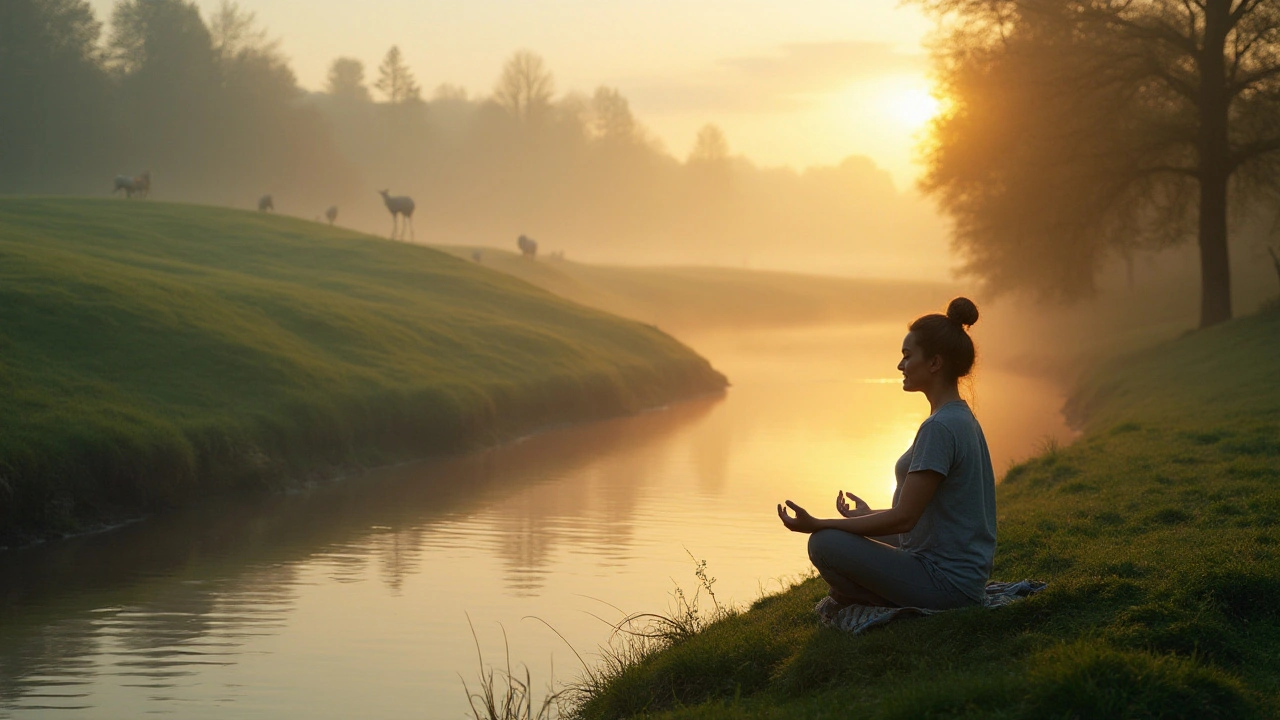
In the hustle and bustle of modern life, finding a moment of peace can feel like a luxury. Yet, calmness is more than just a fleeting feeling—it's a profound way of living that influences your entire being. Imagine shifting your perspective from chaos to clarity, from tension to tranquility. It's not just about reducing stress; it's about nurturing a state of mind that supports your health and happiness.
The power of calmness extends beyond emotional relief. It affects how you interact with the world and your ability to manage challenges with confidence. Embracing calmness means tapping into a source of strength that empowers you to maintain balance in all aspects of life. Let's explore how you can transform your well-being by integrating calmness into your daily routine.
- The Essence of Calmness
- Benefits of Practicing Calm
- Techniques to Cultivate Calmness
- Creating a Calming Environment
- The Role of Calmness in Well-being
The Essence of Calmness
In a world buzzing with notifications and endless to-do lists, the notion of calmness often gets overshadowed. Yet, calmness isn't merely the absence of noise but an intentional stillness that resides deep within us all. It’s a state where mind and body harmonize, creating a space where clarity reigns supreme. When you embrace calmness, you’re not just escaping stress but inviting a profound balance that grounds your existence in this fast-paced world.
Many may wonder why calmness holds such significance in our mental and physical realms. Scientifically speaking, a calm state activates the parasympathetic nervous system, commonly known as the 'rest and digest' system. This system plays a crucial role in reducing the heart rate, lowering blood pressure, and nurturing a sense of relaxation throughout the body. In this synergy, you're more than just at peace; you're in tune with your internal rhythm, fostering holistic health benefits that modern research now embraces.
Consider the day-to-day stress that weighs you down. On such days, accessing calm might seem daunting, if not impossible. Yet, those who consistently practice mindfulness report a profound transformation. The American Psychological Association highlights that even short bursts of meditation or deep breathing can significantly alleviate stress, improve concentration, and even enhance creativity by clearing mental clutter. This reiterates the undeniable impact calmness has on overall mental health.
The beauty of calmness lies in its accessibility. It doesn’t demand fancy retreats or expensive tools, merely a commitment to pause and breathe. Dr. Herbert Benson, a prominent figure in mind-body medicine, often spoke about 'The Relaxation Response.' This response, triggered through deep breathing and meditation, shifts the body's response from stress to serenity. In his words, "The human capacity to evoke calmness is a measure of our control over even the chaos of emotions."
"Stress isn’t present when the mind is calm, free of frenzy. It’s the absence of its noise that emerges clarity,"he often noted.
As we grasp the essence of calmness, the practicality of its application becomes clear. It’s about gradual integration into your daily life. Start with small rituals like mindful walking or reflective journaling. These practices don't just signify the absence of motion but the presence of awareness. This awareness then transpires into decisions that align with a healthier lifestyle. Scientifically, the benefits grow, rooted in a calm state promoting sustainable wellness.
Benefits of Practicing Calm
Embracing calmness is not just about feeling good in the moment. It has a host of lasting benefits that ripple through your life in meaningful ways. One of the most immediate perks is the reduction of stress. When we practice calm, our bodies lower the production of cortisol, a hormone associated with stress. Less cortisol means a decreased risk of chronic stress-related issues such as hypertension, inflammation, and weakened immune response. Studies have shown that people who regularly engage in calming practices like meditation or mindful breathing often report lower levels of anxiety and depression.
Beyond mental health, calmness plays a pivotal role in nurturing physical well-being. It has been observed that those who integrate calm into their daily routines tend to have better sleep quality. A calm mind contributes to falling asleep faster and achieving deeper, more restorative sleep, which is vital for physical health and emotional resilience. As the mind quiets, the body follows, allowing for a natural repair process to occur during sleep.
Another critical aspect is the enhancement of focus and creativity. When your mind isn't cluttered with stress and anxiety, it can redirect energy towards creative pursuits and problem-solving. Creativity thrives on calm; it opens doors to innovative thinking and fresh perspectives. This is particularly beneficial in professional settings where calmness can lead to higher productivity and job satisfaction. As the renowned author and spiritual teacher Eckhart Tolle once said, "True intelligence operates silently. Stillness is where creativity and solutions to problems are found."
Moreover, nurturing a calm demeanor positively affects how you connect with others. Relationships benefit greatly from the patience and understanding that a calm mindset encourages. With a calm heart, you react less to provocations and can engage more deeply with empathy. This enhances communication and strengthens bonds, fostering a more harmonious environment at home and work.
Adopting regular practices to cultivate calm has been linked to longevity and improved quality of life. Research indicates that engaging in activities that promote calmness may enhance life expectancy by reducing stress and its detrimental effects. Thus, integrating these habits could be a vital component of a long-term wellness strategy, promising not only quantity of life but quality as well.

Techniques to Cultivate Calmness
Finding your inner calm may seem challenging, but with the right techniques, it's more than achievable. One of the most effective methods is through mindful breathing. This simple yet powerful practice involves paying close attention to your breath, noticing each inhale and exhale without judgment. To begin, find a quiet spot where you can sit comfortably. Close your eyes and take a deep breath in, feeling the air fill your lungs, and then slowly release it. Repeat this process for a few minutes each day, and you'll likely notice an increase in your capacity for serenity. Studies have shown that regular deep breathing can decrease stress and increase mental focus.
Meditation is another profound tool for cultivating calmness. It doesn't require any fancy equipment—just a willingness to be present with yourself. Start by setting aside five minutes to sit quietly, focusing on a word or phrase that brings peace, such as "calm" or "breathe." If your mind wanders, gently guide it back to the word or phrase without harsh judgment. Over time, meditation can not only boost your overall focus but significantly enhance your emotional resilience.
"Meditation is not a way of making your mind quiet. It's a way of entering into the quiet that's already there—buried under the 50,000 thoughts the average person thinks every day." — Deepak Chopra
Creating a daily routine that incorporates elements of nature can also amplify calmness. Whether it's a walk in the park or simply sitting in your garden, nature has its unique way of rejuvenating your spirit. Beyond just being refreshing, spending time outdoors is linked to reducing levels of the stress hormone cortisol. So, when you feel overwhelmed, a dose of nature could be precisely what you need to refocus and recharge.
Practical Tips for Cultivating Calm
Consistent, small practices can make a big difference in cultivating calmness. Journaling is a great example. Every evening, try writing down three things you're grateful for. This shift in focus can gradually transform your mindset to be more positive and less reactive to stress. Similarly, a brief physical exercise session can work wonders. It helps channel any pent-up energy and aids in balancing your mood. Remember, it's not about intensity but consistency. Just moving your body for 20 minutes a day can have a calming effect over time.
Don't underestimate the calming power of music. Create a playlist of soothing tunes which can instantly shift your mood to a more peaceful state. Listen at the start of the day to establish a serene tone or at night to wind down. By integrating these small yet impactful practices into your life, you create a space where calmness is nurtured and grows, impacting both your mental health and your daily interactions positively.
Creating a Calming Environment
Our surroundings have a remarkable ability to influence our mental state. To cultivate calm, it’s essential to shape your space into a sanctuary of peace. Imagine stepping into a room where each detail has been thoughtfully arranged to offer comfort and relaxation. This space is your refuge, a place designed to help you reset and recharge. Start with lighting—it sets the mood instantly. Soft, warm tones are your best bet, evoking the soothing rays of a setting sun. Avoid harsh, fluorescent lights that can strain your eyes and disrupt your natural rhythms. Consider using candles or lamps with dimming options to adjust based on the time of day or your mood.
Next, focus on decluttering your environment. Clutter is more than just a visual distraction; it can create mental noise that augments stress. Aim for simplicity in your decor choices. Less is more, and each item should serve a purpose or bring joy. This doesn’t mean sacrificing style; rather, it’s about aligning aesthetics with emotional needs. Use storage solutions to keep surfaces clear and create a sense of order and calm. Texture plays a significant role too. Rugs, cushions, and throws made from natural materials like cotton, wool, or linen can introduce warmth and softness. These elements invite physical comfort, which in turn supports psychological relaxation.
Incorporate elements of nature to enhance tranquility. Living plants not only elevate the visual appeal but also purify the air and foster well-being. A simple arrangement of green plants or flowers can breathe life into your room. Research shows that interaction with nature reduces stress and improves mood. If space or maintenance is a concern, opt for easy-to-care-for plants such as succulents or peace lilies. Additionally, windows can open your space to the outdoors, allowing natural light and fresh air to flow through, both crucial for maintaining a peaceful environment.
Soundscapes and Scents
Our sense of smell and hearing significantly influence our perception of space and mood. Calm-inducing soundscapes, like ocean waves or rainfall, can drown out disruptive city noises. Choose recordings or apps that replicate natural sounds or soft background music without lyrics to keep your mind from wandering. Alongside sounds, scents can be powerful allies in creating a calming environment. Lavender, chamomile, and cedarwood are just a few examples of scents known for their calming properties. Essential oil diffusers, incense, or scented candles can be used to subtly infuse your space with these aromas, reinforcing a serene atmosphere.Finally, technology usage should be considered with intention. The constant ping of notifications can be a source of stress and distraction. Designate certain areas of your home as screen-free zones to encourage mindfulness and connection with your immediate environment. This boundary helps you to engage more fully with your surroundings, allowing you to unwind without the constant interruption of screens.
"There is no Wi-Fi in the forest, but you will find a better connection.” – Unknown
These elements—lighting, decluttering, natural textures, soundscapes, scents, and mindful technology use—empower you to construct a personal oasis. This oasis becomes a vital component of maintaining your mental health and nurturing a consistent state of calmness. Transforming your space is a powerful step towards a life imbued with peace, supporting your pursuit of holistic well-being.

The Role of Calmness in Well-being
Calmness plays a fundamental role in laying the groundwork for both mental and physical health. Imagine your mind as a glass of muddy water; when in turmoil, the particles float endlessly, clouding your vision and judgment. But when allowed to stand still, the sediment settles, and clarity emerges—this is what calmness does to your psyche. It acts as a balm, soothing frayed nerves and clearing mental fog. Studies consistently show that reducing stress levels through calmness techniques significantly lowers the risk of mental health issues like anxiety and depression.
The impact of calmness extends to your physical well-being. Chronic stress is a silent saboteur, eroding overall health by increasing the risk of ailments such as heart disease and high blood pressure. When you cultivate a state of calm, your body responds with a series of positive reactions. Your heart rate stabilizes, your muscles relax, and your immune system functions more efficiently. For instance, research indicates that people who practice meditation, a powerful calmness tool, see a reduction in blood pressure that can rival some medications.
But the benefits don't stop there. Your social interactions get a boost as well. A calm demeanor fosters patience and empathy, enabling you to navigate relationships with greater understanding and less conflict. It opens the door to more genuine connections and deeper bonds. In fact, a calm mind is more attuned to social cues and better equipped to react appropriately to complex dynamics at work or home. As American author Leo Buscaglia noted,
"In the end, only three things matter: how much you loved, how gently you lived, and how gracefully you let go of things not meant for you."
Incorporating well-being practices centered on calmness can transform your daily routine. Start with small steps, such as a few minutes of deep breathing each day, gradually carving out more time for activities that promote inner peace. As you embrace calmness, you’ll notice a shift—not just in your mood, but in how you solve problems, make decisions, and interact with the world. A well-known study on mindfulness and its effects found that participants reported higher levels of happiness and satisfaction with life. This inner contentment spreads, enhancing your overall quality of life and providing a foundation of resilience that helps you face any storm with grace.





